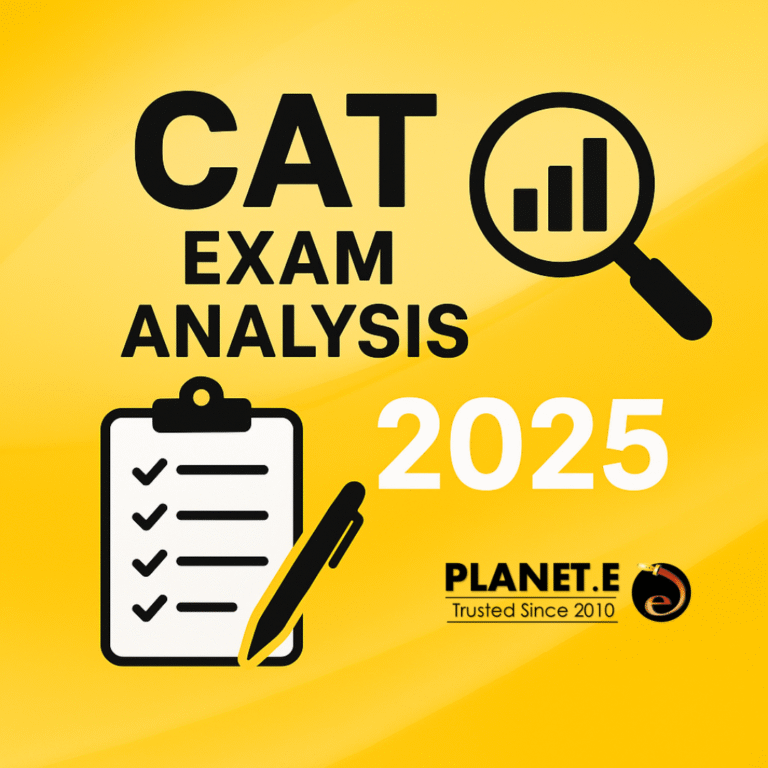
The syllabus for the CAT Quantitative Aptitude
You can achieve a high percentile on the CAT exam by studying the quantitative aptitude syllabus. To learn more about the comprehensive CAT exam syllabus for quants, continue reading!
There are 22 questions in the CAT entrance exam’s Quantitative Aptitude portion that cover algebra, arithmetic, geometry, number systems, and other subjects.
This is the last part of the CAT exam, and you have forty minutes to finish it.
An important factor in raising a candidate’s overall ranking and percentile on the CAT exam is the QA part.
Syllabus for CAT Quantitative Aptitude 2025
Arithmetic, algebra, geometry, number systems, and modern mathematics are all included in the CAT Quant syllabus 2025. The questions in this area are generally rated as moderate to high difficulty by test-takers. The two subjects with the most weight in the CAT Quant syllabus are algebra and arithmetic.
The Quantitative Aptitude component of the CAT Exam Pattern consists of 22 questions with a total score of 66.
The marking scheme states that one mark is subtracted for each erroneous response and three marks are given for each correct response.
There were eight TITA-style questions and fourteen multiple-choice questions in the QA section of the CAT question paper. It was thought to be beneficial to try 16–17 questions.
The CAT Cut-off, which normally falls between the 70th and 85th percentile in the Quantitative Aptitude portion, is determined in large part by the CAT Quantitative Aptitude portion.
Syllabus for CAT Quantitative Aptitude 2025
The four main QA domains’ essential CAT Quant themes are categorized as follows:
IIM CAT QA Broad Area Syllabus |
Key Topics |
CAT Arithmetic Syllabus |
Distance, Time, and Speed
Proportion, Variation, and Ratio Cisterns and Time and Work Pipes The proportion of simple and compound interest in the mixtures of profit and loss averages |
Algebra Syllabus for CAT |
Equations that are linear and quadratic
Particular Equations Modulus and Inequalities Indices and Surds The logarithm Graphs and Functions Polynomials Progression Arithmetic Progression, Geometric Progression (AP, GP, HP) |
Number Theory and Modern Maths Syllabus for CAT |
Combination and Permutation
The likelihood Factor Theory LCM, HCF Divisibility Units Set Theory Factorials Remainders Base System The final two digits Data |
Geometry Syllabus for CAT |
Angles and Lines
Triangles Both polygons and quadrilaterals Circles Trigonometry Coordinate Geometry |
The 2025 CAT Quantitative Aptitude Syllabus Weighting
The amount of questions in the CAT quantitative aptitude test syllabus that are covered in each area is broken down as follows:
CAT QA Syllabus |
Expected Number of questions |
| Arithmetic | 8-10 questions |
| Algebra | 7-8 questions |
| Geometry | 3-4 questions |
| Mensuration | 3-4 questions |
| Modern Mathematics | 1-2 questions |
Latest Changes in CAT Quantitative Aptitude Syllabus 2025
Over the last couple of years, there have been specific changes in CAT exam quantitative aptitude syllabus. These changes have been in the exam pattern and syllabus. You will find the latest changes in the table below:
CAT QA Syllabus and Exam Pattern |
Changes (2019-2020) |
Changes (2020-2024) |
Total Number of Questions |
Reduced to 76 from 100 | Reduced to 66 from 76 |
Raw Score |
Reduced to 228 from 300 | Reduced to 198 from 228 |
Total Number of QA Questions |
Reduced to 26 from 34 | Reduced to 22 from 26 |
How to Succeed in Section 2025 of the CAT Quantitative Aptitude Syllabus
To properly master the quantitative aptitude for CAT syllabus and ace the Quantitative Ability component of the CAT exam 2025, follow these important tips:
Section on Geometry
Concentrate on comprehending basic geometric ideas including triangles, circles, polygons, lines, and angles.
Gain proficiency in visualizing geometric shapes and their characteristics.
Practice using various geometric formulae and theorems to solve problems quickly.
Examine any errors and draw lessons from them to enhance how you handle related issues in the future.
Section on Arithmetic
Topics like ratio and proportion, percentage, profit and loss, time and work, and time and distance should all be very well within your grasp.
Learn the important arithmetic formulae for averages, proportions, ratios, and percentages by heart.
Practice addressing word problems methodically by converting them into mathematical equations.
Concentrate on increasing your math problem-solving accuracy and speed.
Section on Algebra
Gain a solid grasp of algebraic ideas including functions, sequences, equations, and inequalities.
Solve a wide range of algebraic problems, such as simultaneous, quadratic, and linear equations.
Real-world applications like time-speed-distance, time & work, and mixes are frequently included in CAT algebra tasks.
To effectively answer problems and simplify algebraic equations, commit key identities to memory, such as the binomial theorem, the quadratic formula, and the characteristics of exponents.
Top Books for Preparing for the 2025 CAT Quantitative Aptitude Syllabus
Although there is an abundance of CAT study materials available online and in stores, picking the best CAT preparation books is a difficult undertaking. The following table provides comprehensive descriptions of the key CAT test math quant preparation books listed below, which correspond to the CAT quant syllabus:
The best study guides for CAT QA Syllabus 2025 preparation are as follows:
CAT Exam Quantitative Ability Syllabus 2025 Preparations Books |
Author |
| Quantitative Aptitude for the CAT | Nishit K Sinha/Pearson |
| Quantitative Aptitude Quantum CAT | Arihant |
| How to Prepare for Quantitative Aptitude for CAT | Arun Sharma/ Tata McGraw Hill |
| Quantitative Aptitude for Competitive Examinations | RS Agarwal/ S Chand |
| Quantitative Aptitude for CAT | Dinesh k Sinha |
| Quantum CAT | Sarvesh Verma |








